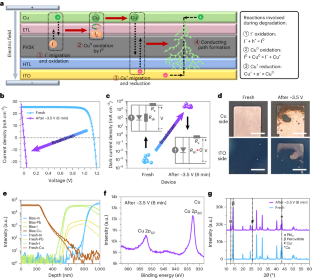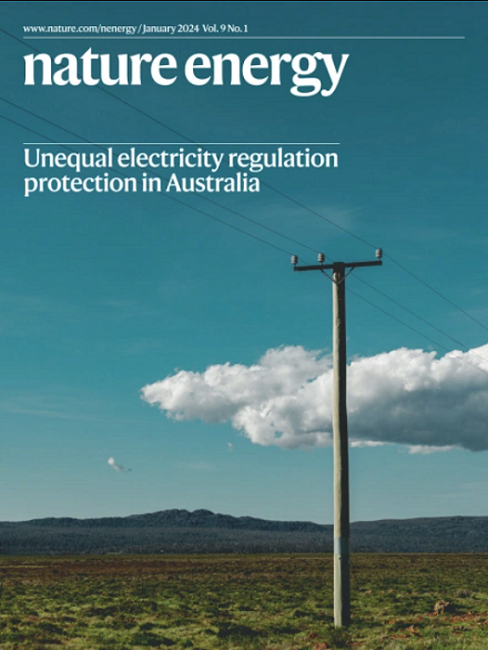Barrier reinforcement for enhanced perovskite solar cell stability under reverse bias
IF 49.7
1区 材料科学
Q1 ENERGY & FUELS
引用次数: 0
Abstract
Stability of perovskite solar cells (PSCs) under light, heat, humidity and their combinations have been notably improved recently. However, PSCs have poor reverse-bias stability that limits their real-world application. Here we report a systematic study on the degradation mechanisms of p–i–n structure PSCs under reverse bias. The oxidation of iodide by injected holes at the cathode side initialize the reverse-bias-induced degradation, then the generated neutral iodine oxidizes metal electrode such as copper, followed by drift of Cu+ into perovskites and its reduction by injected electrons, resulting in localized metallic filaments and thus device breakdown. A reinforced barrier with combined lithium fluoride, tin oxide and indium tin oxide at the cathode side reduces device dark current and avoids the corrosion of Cu0. It dramatically increases breakdown voltage to above −20 V and improved the T90 lifetime of PSCs to ~1,000 h under –1.6 V. The modified minimodule also maintained over 90% of its initial performance after 720 h of shadow tests. The stability of perovskite photovoltaics under reverse bias is limited and thus an issue for real-world applications. Nengxu Li and colleagues report the underlying degradation mechanism at the cathode side and a multilayer barrier to minimize it.


在反向偏压下增强过氧化物太阳能电池稳定性的势垒加固技术
最近,过氧化物太阳能电池(PSCs)在光、热、湿度及其组合条件下的稳定性有了显著提高。然而,PSC 的反向偏压稳定性较差,限制了其在现实世界中的应用。在此,我们报告了对 pi-n 结构 PSC 在反向偏压下的降解机制的系统研究。阴极侧注入的空穴氧化了碘,启动了反向偏压诱导的降解,然后生成的中性碘氧化了金属电极(如铜),随后 Cu+ 漂移到过氧化物中,并被注入的电子还原,导致局部金属丝,从而导致器件击穿。在阴极一侧使用氟化锂、氧化锡和氧化铟锡组合的增强型阻挡层可降低器件暗电流,避免 Cu0 被腐蚀。它将击穿电压大幅提高到 -20 V 以上,并将 PSC 的 T90 寿命提高到 -1.6 V 下的约 1,000 小时。经过 720 小时的阴影测试后,改进后的微型模块还能保持 90% 以上的初始性能。
本文章由计算机程序翻译,如有差异,请以英文原文为准。
求助全文
约1分钟内获得全文
求助全文
来源期刊

Nature Energy
Energy-Energy Engineering and Power Technology
CiteScore
75.10
自引率
1.10%
发文量
193
期刊介绍:
Nature Energy is a monthly, online-only journal committed to showcasing the most impactful research on energy, covering everything from its generation and distribution to the societal implications of energy technologies and policies.
With a focus on exploring all facets of the ongoing energy discourse, Nature Energy delves into topics such as energy generation, storage, distribution, management, and the societal impacts of energy technologies and policies. Emphasizing studies that push the boundaries of knowledge and contribute to the development of next-generation solutions, the journal serves as a platform for the exchange of ideas among stakeholders at the forefront of the energy sector.
Maintaining the hallmark standards of the Nature brand, Nature Energy boasts a dedicated team of professional editors, a rigorous peer-review process, meticulous copy-editing and production, rapid publication times, and editorial independence.
In addition to original research articles, Nature Energy also publishes a range of content types, including Comments, Perspectives, Reviews, News & Views, Features, and Correspondence, covering a diverse array of disciplines relevant to the field of energy.
 求助内容:
求助内容: 应助结果提醒方式:
应助结果提醒方式:


